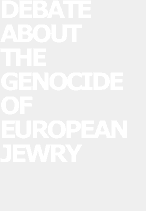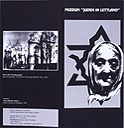
 |
Memory Jews and their organizations were the first to commemorate the genocide. They set up memorials to the slain, they searched for testimonies, they wrote their memoirs. In Israel the museums and memorials Beith lohamej ha'getaot (1948) and Yad Vashem (1953) were dedicated to the genocide and the Jewish resistance. While the Jewish communities in the West commemorated the genocide publicly, it was not possible to do so behind the Iron Curtain. It was only in the aftermath of the liberalization of those societies that consciousness of the genocide of the Jews could be raised. In many Western countries the public debate began with the Auschwitz trials and the trial of Eichmann in the 1960s. In contrast to earlier memory sets, the genocide was no longer seen solely as a Jewish matter in the West. Since then film and television have played a decisive role in changing the perception. The broadcast of the television series "Holocaust" helped to internationalize the topic. In the 1980s a change in the genocide discussion was also felt in the Warsaw Pact states. When the Cold War came to an end, the remembrance split into two directions in most countries. On the one hand, the memory of the genocide of the Jews and the complicity of the respective country were examined. On the other hand, awareness was raised of the crimes committed by the Soviet Union, in particular the Stalinist terror. However, these countries now feel obliged to take over the Western forms of commemoration. At the same time, having suffered great losses, they see themselves as the real victims of wartime. Altogether, the memory of the Second World War and the genocide has become a central component of a growing European public debate. This is reflected not least of all in such events as the "International Holocaust Conference" in Stockholm in 2000 or the "OSCE Conference on Tolerance" in Berlin 2004. That many Holocaust museums have been founded also confirms this trend. Yet it cannot be assumed that the experiences of the West will simply be taken over in Eastern Europe, due to the different course of history those countries have gone through. |
| One of the first Jewish publications about the genocide is "Terezin ghetto", published in 1945. It contains a list of the Jews who were deported to Theresienstadt. The cover shows the enormous walls with the archways. Shadows of a few people can be made out in the huge inner area - a reference to the fact that only few survived. The illustration is one of the first examples of the pictorial tradition that was to come: it can immediately be associated with Theresienstadt. Although Theresienstadt was already turned into a memorial in 1947, under Communist rule almost no attention was paid to the commemoration of the Jewish prisoners - except during the phase of the Prague Spring. | |
| The museum and documentation centre "Jews in Latvia", founded in 1997 in the Jewish Community Centre in Riga, attempts to raise awareness of this chapter of history in Latvia. The memory of the Holocaust plays a central role in this effort. The flyer published by the museum shows a broken Star of David and the portrait of an old woman on the title page. On the back is a photo of the destroyed Great Choral Synagogue of Riga. Compared with the rather reserved earlier brochure, this depiction takes the offensive. |
|
On the tenth anniversary of the "Vel d'hiv raid" the "Amicale des anciens déportés juif s de France", the comrades of the former deported Jews of France, published a flyer. It was meant to recall the "greatest drama during the National-Socialist occupation". It reproduces a photograph of the Jews who were rounded up in the Vélodrome d'Hiver, the Parisian cycling stadium, on July 16, 1942. The title names the "Nazis" explicitly as the perpetrators. That the raids were carried out by the French police is not mentioned in the text. |
|
The photograph showing a boy in the Warsaw Ghetto being "driven out of the bunker" is from Jürgen Stroop's "photo report" to document the suppression of the Warsaw Uprising day by day. With its pitiable message the photograph became an icon of sympathy for the suffering of the Jews, often reproduced and used in photo montages. It is perhaps the most moving and at the same time vexing example of the fact that almost the entire pictorial heritage of the victims was created through the lens of the perpetrators. This fact alone is reason enough to consider every photograph from the time of the Second World War as an object in need of interpretation. |
|







